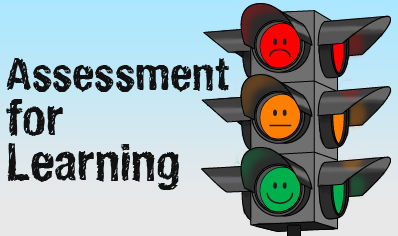In classrooms where assessment for learning is practiced, students know at the outset of a unit of study what they are likely to learn. At the beginning of the unit, the teacher will work with the student to understand what she or he already knows about the topic as well as to determine any gaps or misconceptions (initial/diagnostic assessment). As the unit progresses, the teacher and student work together to evaluate the student’s knowledge, what she or he needs to learn to improve and extend this knowledge, and how the student can best get to that point (formative assessment).
Assessment for learning happens at all stages of the learning process.
Researchers whose work has informed much of this assessment reform include Ken O’Connor, Grant Wiggins, Jay McTighe, Richard Stiggins, Paul Black and Dylan Wiliam, Thomas Guskey, Damian Cooper and Ronán Howe
Historical Perspective
In past decades, teachers would structure a unit of study that would typically include objectives, teaching strategies, and resources. An evaluation component—the test or examination—may or may not have been included as part of this design (Cooper, 2006). The student’s mark on this test or exam was taken as the indicator of his or her understanding of the topic.
Definitions
There are numerous assessment terms that will appear in any discussion of assessment. Listed below are common interpretations of some of these terms:
A working definition of Assessment for learning from a widely cited article contends:
“the term ‘assessment’ pertains to all those activities undertaken by teachers, and by their students in assessing themselves, which provide information to be used as feedback to modify the teaching and learning activities in which they are engaged.
Educators have differentiated assessment according to its purpose:
Assessment for learning
comprises two phases—initial or diagnostic assessment and formative assessment
assessment can be based on a variety of information sources (e.g., portfolios, works in progress, teacher observation, conversation)
verbal or written feedback to the student is basically descriptive and emphasizes strengths, identifies challenges, and points to next steps
as teachers check on understanding they adjust their instruction to keep students on track
no grades or scores are given – record-keeping is primarily anecdotal and descriptive
happens throughout the learning process, from the outset of the course of study to the time of summative assessment
Assessment as learning
initiates as students become aware of the goals of instruction and the criteria for performance
involves goal-setting, monitoring progress, and reflecting on results
implies student ownership and responsibility for moving his or her thinking forward (metacognition)
happens throughout the learning process
Assessment of learning
assessment that is accompanied by a number or letter grade (summative)
compares one student’s accomplishment with standards
results can be conveyed to the student and parents
occurs at the end of the learning unit
Evaluation
judgment made on the basis of a student’s performance
Diagnostic assessment (now referred to more often as “pre-assessment”)
assessment made to determine what a student does and does not know about a topic
assessment made to determine a student’s learning style or preferences used to determine how well a student can accomplish a certain set of skills related to a particular subject or group of subjects
happens at the beginning of a unit of study
utilized to inform instruction: makes up the initial phase of assessment for learning
Formative assessment
assessment made to determine a student’s knowledge and skills, including learning gaps as they progress through a unit of study
used to inform instruction and guide learning
occurs during the course of a unit of study
makes up the subsequent phase of assessment for learning
Summative assessment
assessment that is made at the end of a unit of study to determine the level of understanding the student has achieved
includes a mark or grade against an expected standard
